| Author |
Message |
Merv Cannon

|
 Posted: Sun 11 Feb, 2007 11:53 pm Post subject: Mounted Condottiere Sword Posted: Sun 11 Feb, 2007 11:53 pm Post subject: Mounted Condottiere Sword |
 |
|
I came across this image from this site here.... http://www.paradoxplace.com/Insights/Equestrian/Equestrians.htm ...and I wondered when I saw that the Longsword seems to not have a full scabbard. It seems to be only about 12 inches long and the blade seems bare. I have seen this type of sword suspension in Landsknecht woodcuts but never on a mounted warrior. The sculpturers, one of whom was Michangelo's teacher, paid very great attention to detail in this statue as this Condottiere was very important in Venice. IMHO, it is unlikely that much artistic licience was used.
Wouldnt a sword suspended like this hurt the horse or is the blade too long to get in the way ? Does anyone else have any illustrations of unusual suspensions, mounted or otherwise ?
I am interrested to hear your feedback.
 Attachment: 88.53 KB Attachment: 88.53 KB
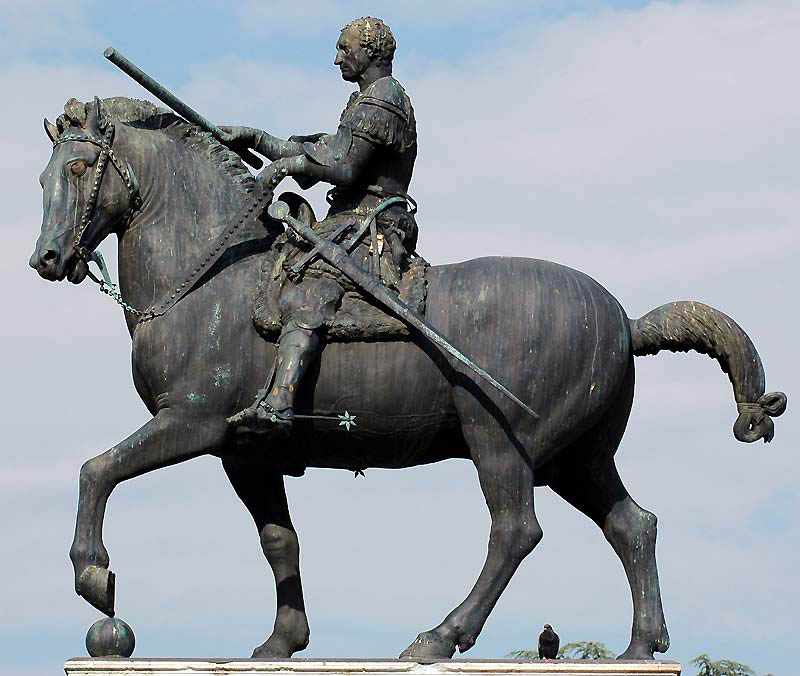
 Attachment: 84.36 KB Attachment: 84.36 KB
[ Download ]
Merv ....... KOLR
http://www.lionrampant.com.au/
"Then let slip the dogs of war ! "......Woof !
|
|
   |
 |
Nathan Robinson
myArmoury Admin


|
|
    |
 |
|
Peter Johnsson
Industry Professional
|
 Posted: Mon 12 Feb, 2007 1:01 am Post subject: Posted: Mon 12 Feb, 2007 1:01 am Post subject: |
 |
|
Why do you think the blade is bare?
Scabbards were slim and thin.
They did not build much volume around the blade, that is why it might seem likte the blade is bare.
The suspension is typical for this period: two knots with thongs to attach to the waist belt.
|
|
   |
 |
Merv Cannon

|
 Posted: Mon 12 Feb, 2007 1:35 am Post subject: Condittiere Sword Posted: Mon 12 Feb, 2007 1:35 am Post subject: Condittiere Sword |
 |
|
| Peter Johnsson wrote: | Why do you think the blade is bare?
Scabbards were slim and thin.
They did not build much volume around the blade, that is why it might seem likte the blade is bare.
The suspension is typical for this period: two knots with thongs to attach to the waist belt. |
Hi Peter........Did you download the Close-up image ? I ran the image through "Photoshop"...some different filters and blew it right up and I can see absolutely no trace of a scabbard whatsoever ...not a tip or a chape or a sliver. The Sword-tip is very sharp and although I know that scabbards can be quite tailored ( I make them ) ... I have never seen any scabbard this sharp. I checked the image very carefully before posting ! You can see the end of the short suspension piece. Its not at all an uncommon way to suspend a longsword in central Europe ( I'll post some more references presently ) , I've just never seen one on a mounted soldier before.
Cheers !
Merv ....... KOLR
http://www.lionrampant.com.au/
"Then let slip the dogs of war ! "......Woof !
|
|
   |
 |
Merv Cannon

|
 Posted: Mon 12 Feb, 2007 2:08 am Post subject: Condittiere Sword Posted: Mon 12 Feb, 2007 2:08 am Post subject: Condittiere Sword |
 |
|
| Nathan Robinson wrote: | That's fascinating... very good find.
I'd be interested to see the woodcuts showing similar hangers.
Is it a bare blade? I'm not certain...
Thank you. |
These photos are not in a very high resolution and so I've been trying to find sharper ones on the web. I have typed in just about every word I can think of including Padova and Donatello without much luck so far. You gotta just love the web sometimes, huh ?.... I type in " Donatello " and end up with three hundred shots of a Mutant Ninja Turtle !! 
 Attachment: 97.65 KB Attachment: 97.65 KB
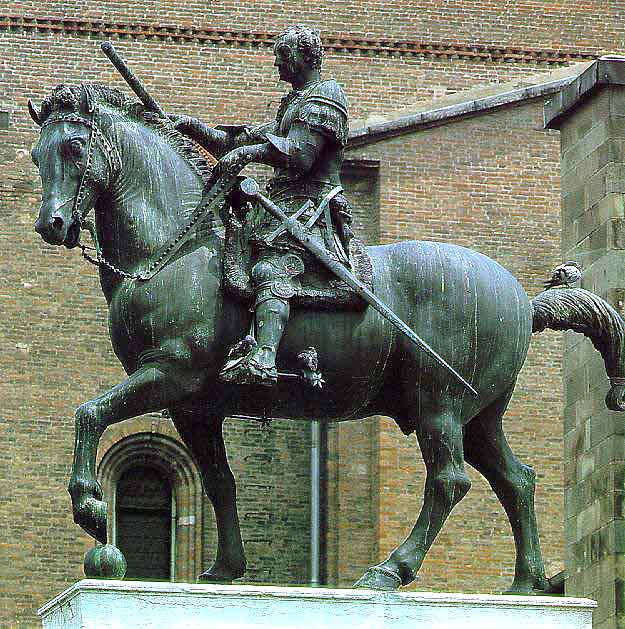
Merv ....... KOLR
http://www.lionrampant.com.au/
"Then let slip the dogs of war ! "......Woof !
|
|
   |
 |
Vincent Le Chevalier

|
 Posted: Mon 12 Feb, 2007 2:56 am Post subject: Posted: Mon 12 Feb, 2007 2:56 am Post subject: |
 |
|
| Merv Cannon wrote: |
These photos are not in a very high resolution and so I've been trying to find sharper ones on the web. I have typed in just about every word I can think of including Padova and Donatello without much luck so far. You gotta just love the web sometimes, huh ?.... I type in " Donatello " and end up with three hundred shots of a Mutant Ninja Turtle !! WTF?!
|
Well, yeah 
The keywords that seem to be the most successful are 'Donatello Gattamelata'...
The highest resolution I found is here but unfortunately you don't get much more details because the quality of the photo is slightly lower (beware that the page is difficult to load, I had to hit refresh quite a few times to finally get it). I believe that if you follow the links starting from the Google image search you could find better shot of the sword.
Regards
--
Vincent
Ensis Sub Caelo
|
|
   |
 |
|
Jonathon Janusz
|
 Posted: Mon 12 Feb, 2007 4:55 am Post subject: Posted: Mon 12 Feb, 2007 4:55 am Post subject: |
 |
|
I didn't see sculpted in the statue anything that would show where the "scabbard" ends and the blade begins to suggest that it doesn't go all the way to the tip. . .
Maybe I missed something?
|
|
  |
 |
|
Alberto Dainese
|
 Posted: Mon 12 Feb, 2007 6:04 am Post subject: Re: Condittiere Sword Posted: Mon 12 Feb, 2007 6:04 am Post subject: Re: Condittiere Sword |
 |
|
| Merv Cannon wrote: | | These photos are not in a very high resolution and so I've been trying to find sharper ones on the web. |
Well, if you need I can go to Piazza del Santo and just take a couple of pics for you, but it could take some time before I can go there when there is full daylight.
Sani!
|
|
  |
 |
Merv Cannon

|
 Posted: Mon 12 Feb, 2007 6:29 am Post subject: Re: Condittiere Sword Posted: Mon 12 Feb, 2007 6:29 am Post subject: Re: Condittiere Sword |
 |
|
| Alberto Dainese wrote: | | Merv Cannon wrote: | | These photos are not in a very high resolution and so I've been trying to find sharper ones on the web. |
Well, if you need I can go to Piazza del Santo and just take a couple of pics for you, but it could take some time before I can go there when there is full daylight.Sani! |
Alberto...........Hey thanks ! That would be great. Certinally no hurry, dont go out of your way or anything. So if you could get a nice close up of the suspension and also the blade/scabbard and the tip, that would be most helpful.
Very much appreciated....
Thank you !
Merv ....... KOLR
http://www.lionrampant.com.au/
"Then let slip the dogs of war ! "......Woof !
|
|
   |
 |
Bruno Giordan

|
|
  |
 |
Richard Fay

|
 Posted: Mon 12 Feb, 2007 8:55 am Post subject: Posted: Mon 12 Feb, 2007 8:55 am Post subject: |
 |
|
Hello all!
I agree with Bruno, there definitely appears to be a sculpted "triangle" over the central part of the cross, indicating a typical triangular overlap of the scabbard cover over the central part of the cross. I could see it if I looked carefully at the side-view photo posted earlier, but it's definitely visible in the head-on view.
My question would be this; did every period scabbard have a chape at it's end? Could this be a case of a scabbard without a chape, making it appear as if the blade were carried bare in the loops, or is the chape just indistinct? Could the tip of the scabbard, since it's small and juts out, have suffered differential wear? Could the finer details like a chape have been lost over time?
When you think about how narrow the blade represented in the statue must have been, you realize that it represents a definite thrusting-sword. That weapon must have been a wicked thruster, certainly not a dedicated cutter by any means. Almost an estoc.
Neat statue, though. I've always liked this one.
Cowabunga!  (Sorry, I couldn't resist!) (Sorry, I couldn't resist!)
 Attachment: 8.64 KB Attachment: 8.64 KB
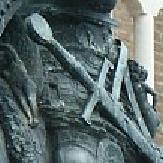
Close-up of sword's cross on statue.
 Attachment: 6.87 KB Attachment: 6.87 KB

Close-up of scabbard's tip on statue.
"I'm going to do what the warriors of old did! I'm going to recite poetry!"
Prince Andrew of Armar
|
|
 |
 |
Nathan Robinson
myArmoury Admin


|
|
    |
 |
Bruno Giordan

|
 Posted: Mon 12 Feb, 2007 10:41 am Post subject: Posted: Mon 12 Feb, 2007 10:41 am Post subject: |
 |
|
| Richard Fay wrote: | Hello all!
I agree with Bruno, there definitely appears to be a sculpted "triangle" over the central part of the cross, indicating a typical triangular overlap of the scabbard cover over the central part of the cross. I could see it if I looked carefully at the side-view photo posted earlier, but it's definitely visible in the head-on view.
My question would be this; did every period scabbard have a chape at it's end? Could this be a case of a scabbard without a chape, making it appear as if the blade were carried bare in the loops, or is the chape just indistinct? Could the tip of the scabbard, since it's small and juts out, have suffered differential wear? Could the finer details like a chape have been lost over time?
When you think about how narrow the blade represented in the statue must have been, you realize that it represents a definite thrusting-sword. That weapon must have been a wicked thruster, certainly not a dedicated cutter by any means. Almost an estoc.
Neat statue, though. I've always liked this one.
Cowabunga!  (Sorry, I couldn't resist!) (Sorry, I couldn't resist!) |
Just neat you say? that's one of the peaks of the Renaissance!
Shame on the Padua's administration that keeps it under a pidgeons' rain of excrements while very unsubstantial other initiatives are publicly financed (Donatello and Gattamelata won't vote at next elections ...).
|
|
  |
 |
Bruno Giordan

|
 Posted: Mon 12 Feb, 2007 10:50 am Post subject: Posted: Mon 12 Feb, 2007 10:50 am Post subject: |
 |
|
Couple of observations.
look at the cross: unusual (straight, very thick, a volute at the two ends), is more an architetcural element than a real cross.
So don't take the statue as too realistic on such details: it is realistic just as for the body and teh face, this was the focus of renaissance art, body proportions.
Gattamelata is depicted as a roman consul (please notice the roman breastplate gaily mingled with a period armor).
As for the roman statuary, the facial features are realistic with just a bit of idealization.
Even hairdo is typically ancient roman style, as it is the angel-like winged face on the breastplate.
The position is similar to that of Rome's Marc'Aurelio emperor (one of the few bronze statues to survive from the roman age).
Renaissance sculptors were concentrated mainly on studyng the math behind the proportions of things, a sword scabbard was not their primary concern for sure.
It is a masterwork of lost wax fusion too.
|
|
  |
 |
Steve Grisetti

|
 Posted: Mon 12 Feb, 2007 10:56 am Post subject: Posted: Mon 12 Feb, 2007 10:56 am Post subject: |
 |
|
All of the discussion on this statue has been about full scabbard vs. partial scabbard, and that's great because that is the basis for the thread. But, what really impresses me most about the statue is the horse. This strikes me as a marvelous representation of an immensely powerful and majestic animal!
"...dismount thy tuck, be yare in thy preparation, for thy assailant is quick, skilful, and deadly."
- Sir Toby Belch
|
|
  |
 |
Bruno Giordan

|
 Posted: Mon 12 Feb, 2007 11:40 am Post subject: Posted: Mon 12 Feb, 2007 11:40 am Post subject: |
 |
|
| Steve Grisetti wrote: | | All of the discussion on this statue has been about full scabbard vs. partial scabbard, and that's great because that is the basis for the thread. But, what really impresses me most about the statue is the horse. This strikes me as a marvelous representation of an immensely powerful and majestic animal! |
people who mantain that knighs were not using draft horses should regard this portrait with a certain interest: its is an heavy horse indeed, I'm not an expert but this is definitely not an arab horse.
|
|
  |
 |
Richard Fay

|
 Posted: Mon 12 Feb, 2007 1:29 pm Post subject: Posted: Mon 12 Feb, 2007 1:29 pm Post subject: |
 |
|
| Nathan Robinson wrote: | | So.... about those woodcuts? |
Hey Nathan! 
How about one woodcut and one illuminated manuscript image? I'm not sure if these would be considered to have identical suspension systems to that seen on the Gattamelata statue, but they are roughly similar. These were the closest I could find in a quick search for period images. I'm sure there are more out there, but it's a start.
Both images are from the British Library. The first is from a woodcut of a man on horseback by Luis Rodriguez, dated 1540. Note the double loop shown on the scabbard. Some of the details are obscured by things in front of the scabbard, like the mace or sceptre in his hand.
The second image is a miniature from Des cas des nobles hommes, a French manuscript of circa 1420. I thought the suspension attached to the scabbard laying on the ground looked roughly similar to that shown in the later woodcut, and possibly to that shown on the Gattamelata statue.
 Attachment: 73.41 KB Attachment: 73.41 KB
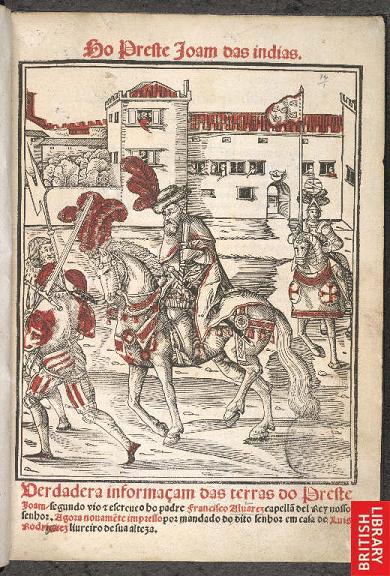
Man on horseback, Luis Rodriguez, Lisbon, 1540.
© The British Library Board
 Attachment: 67.05 KB Attachment: 67.05 KB
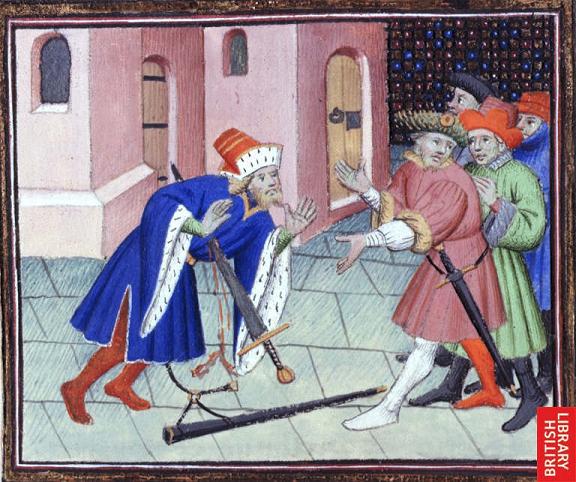
Mark Antony falling on his sword, Master of the Cite de Dames, France, circa 1420.
© The British Library Board
"I'm going to do what the warriors of old did! I'm going to recite poetry!"
Prince Andrew of Armar
|
|
 |
 |
Richard Fay

|
 Posted: Mon 12 Feb, 2007 2:13 pm Post subject: Posted: Mon 12 Feb, 2007 2:13 pm Post subject: |
 |
|
And how about a woodcut, and an engraving, and a painting...
I found more period images that may show a similar style suspension system to that shown on the Gattamelata statue. These were all found on the Web Gallery of Art web site.
The first two images are both by Albrecht Durer. The first is a woodcut of a knight and a landesknecht dated to circa 1497. notice that the mounted knight has a suspension system of loops similar to that shown at the hip of the landesknecht. The loops of the knight's system are just closer together. This could be to adjust the "hang" of the scabbard, but that's only speculation.
The second image is a rather famous engraving by Durer. It depicts a knight, death, and the devil, and dates to circa 1513. Again, certain details may be different, but the scabbard suspension consists of looped straps. Like the previous image, this system appears used by a knight (or at least an armoured horseman).
The third image is a painting of St. Michael by Perugino, dated circa 1500. Note that, yet again, the armoured saint has the scabbard suspended by looped straps. I find this one of particular interest because of the shape of the long, narrow blade, as suggested by the scabbard outlines. The cross and pommel of the saint's sword are daintier than that on the Gattamelata statue, but the blade of St. Michael's sword is very similar to that shown on the statue. In this case, if the painting wasn't coloured, it might be interpreted as a bare blade. However, the scabbard is clearly of a red colouration.
 Attachment: 110.42 KB Attachment: 110.42 KB

The knight and the landesknecht, Albrecht Durer, circa 1497.
© Web Gallery of Art
 Attachment: 87.66 KB Attachment: 87.66 KB

Knight, death, and the devil, Albrecht Durer, circa 1513.
© Web Gallery of Art
 Attachment: 86.96 KB Attachment: 86.96 KB
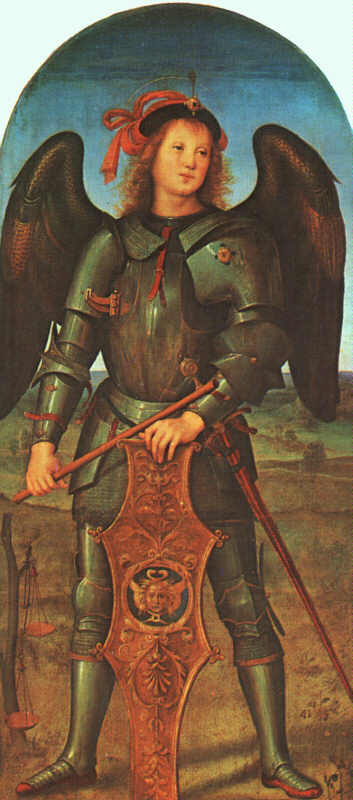
St Michael by Perugino, circa 1500.
© Web Gallery of Art
"I'm going to do what the warriors of old did! I'm going to recite poetry!"
Prince Andrew of Armar
|
|
 |
 |
|
Rod Walker
Location: NSW, Australia. Joined: 05 Feb 2004
Posts: 230
|
 Posted: Mon 12 Feb, 2007 2:46 pm Post subject: Posted: Mon 12 Feb, 2007 2:46 pm Post subject: |
 |
|
| Bruno Giordan wrote: |
people who mantain that knighs were not using draft horses should regard this portrait with a certain interest: its is an heavy horse indeed, I'm not an expert but this is definitely not an arab horse. |
It is hardly a draught horse. Note the lack of feathers on the feet, the small dainty hooves, the small well formed head with a hint of Arab blood and the fact that the horse looks to be about 15.2hh-16hh.
If anything that statue looks a lot like my 16hh Spanish horse.
I'll say it just one more time. They did not ride farm horses.
Cheers
Rod
Jouster
www.jousting.com.au
"Come! Let us lay a lance in rest,
And tilt at windmills under a wild sky!
For who would live so petty and unblessed
That dare not tilt at something, ere he die?"
--Errantry, John Galsworthy
|
|
   |
 |
Nathan Robinson
myArmoury Admin


|
 Posted: Mon 12 Feb, 2007 3:05 pm Post subject: Posted: Mon 12 Feb, 2007 3:05 pm Post subject: |
 |
|
Hi Rick-
Thanks for the images. I was asking to see "partial scabbards" with exposed blades sticking out. I don't see the ones that you posted as being that. Are we seeing something different from one another? Help me get on the same page.
I have seen the knotted suspension all over the place. It was very common. The interesting and unusual assertion of this topic was the discussion of the sword carried with an exposed blade. That is what I'm trying to see documented.
Thanks!
.:. Visit my Collection Gallery :: View my Reading List :: View my Wish List :: See Pages I Like :: Find me on Facebook .:.
|
|
    |
 |
|
|

